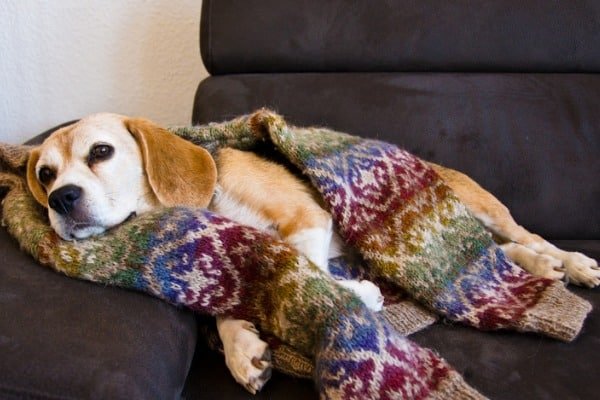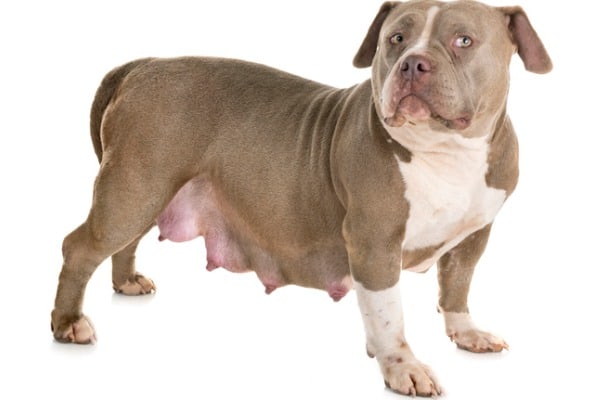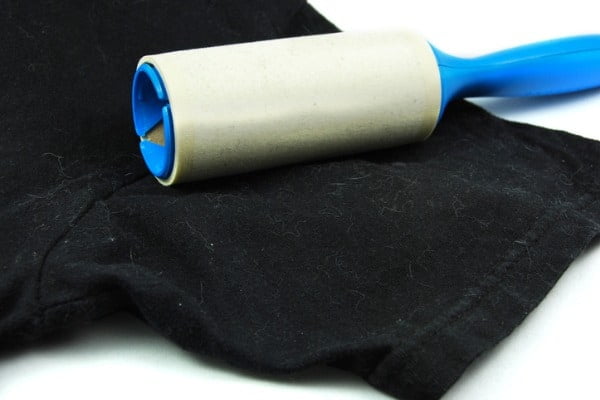So your dog thinks your sweater collection is really their personal bed.

Your laundry basket?
The perfect place to have an afternoon nap.
What about the closet?
According to them, it’s a safe haven and cozy burrow.
Your dog might be going so far as helping themselves to clothes on shelves, hangers, or even drawers – by pulling it down to floor level where they can make a bed.
Some dogs go so far as settling in on dirty laundry or climbing directly in the soiled clothes basket.
If you come home to laundry that’s been turned into a sleeping spot, you might think your dog has an addiction to your clothing.
We’ve been there!
You’re probably thinking, “what’s the deal? Why does my dog lay on my clothes?”
There are several answers to this puzzling, sometimes inconvenient behavior – and plenty of solutions to dial down the stray hair on your garments.
The Simplest Solution
In some cases, your dog is using your clothes as bedding because they don’t have an acceptable spot to sleep.
That doesn’t mean you failed them as a pet parent or are neglectful in any way.
Your dog could have access to a luxury pet bed in the house and still choose to sleep atop a pile of your clothes.
If that’s the case:
There’s something off about their designated bed.

It could be in a spot they don’t like in a room they’re afraid of, or there could be something about the material that doesn’t agree with them.
They might simply be extremely picky about their sleeping spots.
It’s hard to pinpoint why dogs don’t always like perfectly lovely dog beds.
Sometimes:
It will require a little trial and error on your part before you find an arrangement your dog approves of.
In the meantime:
Your dog will seek other sleeping alternatives – like your clothes.
This option is often their first choice for a lot of reasons, which we’ll cover soon.
For now, just remember that clothes have a familiar smell to them, and the materials can be quite inviting.
It’s the same reason your dog might sleep on you instead of in more comfortable spots.
Wool sweaters are popular among animals as well, even if they’d rather sleep on them than wear them.
Moving their bed somewhere else in the house can be the easiest solution, especially if you can move it to where they’ve been setting up camp.
If they prefer sleeping in your closet, try relocating the bed in there and see how they react.
If they still have an aversion to the bed, they might be a little needy in the nesting materials department – meaning they prefer extra blankets and bedding instead of just a bed.
Of course:
Your sherpa hoodie and winter coat aren’t ideal snuggling materials for your dog.
However, most dogs are more after that cuddle factor that comes with your comfy clothes, and you can try replacing your clothes with some blankets that are especially for your dog.
If this solution fails too?
There are a few things that could be going on, including the bed itself being offensive to your dog.
In some cases, it’s a total mystery why your dog doesn’t like a decent bed.
Smells, materials, and even noises the bed might make when your dog settles into it can be enough to put your dog off an otherwise nice bed.
It might be time to give in and try out a different type of dog bed.
The old one might not be a total loss, though – many animal rescues will happily accept clean, secondhand bedding.
So, what if the bed isn’t the problem?
More on that next.
Missing You

Your dog has a sharp sense of smell, and your clothes don’t have to smell like your perfume or cologne for your dog to pick up your scent from them.
Even clothes straight out of the dryer can remind your dog of you, although they might tend to be attracted to clothes you’ve worn but not washed.
If you’re wondering – why does my dog like to sleep on my dirty clothes – it’s because they smell even more like you than clean ones.
Have you ever left your dog for a long period – with a sitter, at a kennel, or even daycare – and left a familiar-smelling clothing article with them?
There’s a reason this can help ease their sorrow of being separated from you and why many boarding facilities will recommend it.
It can be very comforting, especially for dogs who get nervous without their humans.
So, of course:
If your dog misses you, they could seek out your clothes to feel closer to you.
A dog who is missing you could display behavior ranging from dragging out a single shoe to tearing down your entire closet and curling up on it – the latter being a symptom of severe separation anxiety.
Dog separation anxiety can spiral out of control – to the point of a dog becoming destructive – if it’s left ignored.
A dog who is dismantling your entire wardrobe or raiding the laundry room needs desensitizing and behavior therapy.
Not only will it help protect your belongings (ever had to get urine out of your clothes?), but it will also give your dog a much less stressful existence.
For an immediate solution to the clothes issue, going cold turkey might seem like the route to take.
However, it can cause your dog even more anxiety and stress if you take away their coping mechanisms.
You should definitely restrict access to your clothing, either through closed, secured doors or gates.
Offer your dog a compromise by giving them one article of clothing after you’ve closed off your closet and laundry room.
An old t-shirt that you’ve worn but not washed is a perfect gift for a dog who is struggling with separation anxiety.
Trust us:
While you and your dog are working on desensitization, a single shirt can help them not be overwhelmed by sudden changes in the situation.
For anxious dogs, sleeping on your clothes is their stress relief.
If you take away their stress relief all at once, they can turn to other means of venting their frustration, which can get destructive.
Sometimes:
Separation anxiety is a bit more complicated. It could involve missing someone who has passed away or is gone for long periods of time.
A dog missing someone who is no longer living is a heartbreaking and emotionally challenging hurdle to overcome. Dragging out clothes is a sign of grief and must be handled delicately.
Dogs can heal from grief over time the same way humans can, and the best thing you can offer a grieving dog is time and patience.
A dog who is missing someone who is away long-term because of deployment or school, for example, might experience symptoms similar to grief.
In both cases, offering them an article of clothing or two from the person they miss is both a kind and effective way to help them through a rough time.
Expectant Mothers

If your dog is pregnant, they might sleep on your clothes and raid the laundry baskets for nesting material.
A pregnant dog trying to make a cozy spot out of clothes is nesting and preparing to give birth.
If you’ve rescued a stray female and observed this behavior, it’s probably time to get them to a vet and check for pregnancy.
A female wanting to nest on your clothes might prefer the closet at the same time; dogs in labor highly covet den-like spaces.
Other signs of a dog ready to give birth are general restlessness, vomiting, refusal to eat, or clinginess to you.
If you’ve taken in a dog who is displaying these symptoms, it might be too late to get a vet to confirm the pregnancy – although it’s advisable to call the vet for further instructions.
Don’t go it alone.
If the pregnancy is planned or at least expected, then you probably know the drill already.
A dog nesting in your clothes is making preparations for her puppies.
Unless you are on board with your dog giving birth on the contents of your wardrobe, you’ll need to offer acceptable alternatives to your clothing.
Plus:
Puppies can become tangled, smothered, or hidden and squished under clothes, which is enough to ruin everyone’s day.
A better alternative is large articles of bedding, such as a bath towel or a blanket.
They’re safer for new puppies and also easier to remove and clean.
Arctic Weather

You might not live in the Alaskan wilderness, but a cold house can make your dog act as though you do.
Winter weather is often rough on dogs, particularly short-haired and toy breeds.
Remember:
Dogs spend much of their time at floor level, which is the coldest part of the room unless you have heated flooring.
A dog who otherwise likes their bed might seek out your clothing in the winter months because it keeps them warmer.
In this situation:
The first thing to do is to investigate the area where their bed is.
Silly as it might seem, you should sit in the spot and see if you feel any fluctuations in temperature or drafts.
If the bed is near a window or in a chilly corner of the room, your dog will prefer the closet and snuggly clothes to make a nest from.
Try moving the bed somewhere warmer, such as near a vent or somewhere that gets more sun.
Direct sunlight on a dog’s bed is often plenty to tempt them into it.
If they still prefer your clothes over their usual bed, they’re probably still too cold.
Add some extra bedding to their dog pillow or offer an enclosed bed to help them keep warm.
Elevating their bed or other tricks can also encourage them to sleep in their designated spot instead of on clothes.
Another sign your dog is cold while sleeping is if you find them sleeping on your head at night…but that’s a whole other subject.
Removing the Hair

If you’re dealing with the issue of your dog sleeping on your clothes, then you almost certainly have the added problem of hair on everything from shirts to pants.
Since we’ve covered the common reasons and solutions for getting your dog off of your clothes, we’ll include a few words on getting the dog hair off of your clothes.
The easy answer is a lint roller, which is frequently all it takes to pick up the hair.
In a pinch, packing or masking tape can lift off most of the hair.
If that doesn’t do the trick?
Dog hair can work its way into the weave of the fabric, sometimes to the point that a lint roller won’t get it all out.
In this case, throwing the clothes into the dryer on low or no heat can work wonders for shaking the hair out.
The best part?
It’ll get caught in the lint trap for easy disposal.
What about clothes that aren’t dryer-safe?
If they’re good to go in the washing machine, a cup of white vinegar added to the water will help loosen and also repel hairs from the fabric by reducing static.
What if you’re dealing with delicate fabric that is dry-cleaned only?
The last resort before taking your clothes to the dry cleaner is going over them with a rubber glove, like the ones you might use while you wash dishes.
The rubber is good at grabbing individual hairs and pulling them loose.
Keep (Most of) the Clothes for Yourself
Why does my dog go to the closet and sleep on my clothes?
If the bed doesn’t cut it for your dog, there’s usually a good reason – at least in your dog’s eyes.
A little detective work will help you figure out why exactly your dog sleeps on your clothes and how you can offer up a better solution for all parties involved.
With the exception of an old shirt for a dog with stress and anxiety, your clothing should be kept off-limits to your dog.
After all, clothes can be expensive.
Even if they’re not, nobody wants their favorite shirt to be repurposed as a blanket when the dog has their own bedding.
You understandably want your clothes to be hair and smell-free, and there are better alternatives for bedding for a dog who isn’t happy with a plain dog bed.
So you can stop thinking, why does my dog sleep on my clothes, as now you know!
A little indulgence for your dog is often the best solution for everyone.
